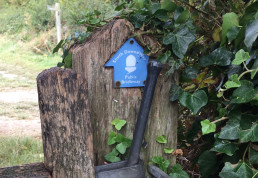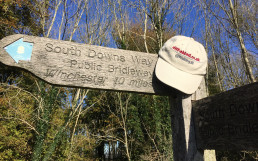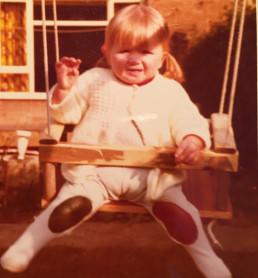Adult DDH: walking and talking with different abilities
Last weekend I walked another 14.5miles, and on the first day I was joined by two friends. I was born with hip-dysplasia and it was obvious immediately that my hips weren’t normal. I knew nothing of Adult DDH until I found Steps Charity last year. It turns out that many people are diagnosed in their 20s and 30s rather than as children, as hip checks for babies don’t always catch DDH – as was reported recently by the BBC.
On day one of this walk I set off from Pyecombe and walked the
three miles uphill to Ditchling Beacon – one of the most popular parts of the South
Downs Way. There I met Sam Beale – who had
contacted me after reading my blog last year.
Sam supports Steps Charity and was diagnosed with DDH in her early 30s –
almost three years after experiencing hip-pain mid-way through pregnancy. You can read more about Sam’s
story here and what strikes me most is how long it took to get a diagnosis
of Adult DDH. As Sam said to me, a
common problem is that doctors think you’re “too young for joint problems” so don’t
think to look for so many conditions and especially hip-dysplasia. After 3 years
Sam had a PAO; surgery which breaks and re-aligns the pelvis in three places and
takes considerable time and pain to recover from.
Sam and I walked along the ridge of the Downs from Ditchling
Beacon towards Black Cap with her joyous dog Amber darting to every passer-by to
say hello. It was a clear and sunny day
with spectacular views to surrounding villages and even out to sea. It was so amazing to meet someone whose story
of diagnosis is so different, and yet we have so many shared challenges. Like walking downhill (if you have DDH it’s
unlikely that “it’s all downhill from here” is motivating). Or squatting exercises in the gym (hip
dysplasia comes with flat as a pancake buttocks). Or simply trying to judge how far you can
walk without being in pain the following day.
For the second half of my walk I was joined by my good
friend Hayley Manning. Hayley and I sing
together, and she also writes a blog about
grief and loss. She is currently training
for a three peaks challenge to raise money for Child Bereavement UK. What I
love about Hayley is her ability to really connect with people and it was
lovely to share part of my walk as she trained for hers. We sat at the ridge of
Black Cap eating sandwiches and putting the world to rights (obvs) before
making our way downhill to enjoy a cuppa at Housedean Farm where I was staying
overnight.
One of the things we talked about was the reaction adults
vs. children have to people who are different.
I recently heard a brilliant programme on BBC
Radio 4 about awkwardness – and how managing other’s reactions and awkwardness
is one of the hardest challenges differently-abled people face because as
adults we’re trained not to ask the obvious questions that a child would. Kids
aren’t awkward – they see something different, they ask why, and they accept
the answer.
I felt very blessed to have had two such wonderful people to
share my walk, and I’ll be posting a social walk shortly to invite others to
come and walk with me as I reach the end of my challenge.
Day two I walked alone. Although it was predicted to pour
with rain all day actually I just got intermittent drizzle. Heading uphill from the A27 I was soon on the top
of the ridge. OK, so when I say soon, I
mean it took me over an hour. I was
passed (four times) by a couple who were training for the Beachy Head Marathon
by running up and down the hill, and it was lovely to chat to them about what
we were each training for. Different-abilities,
different challenges yet each of us were pushing ourselves to the max in the
same great landscape. I then had a
thrilling walk along the ridge – views of pretty churches towards Lewes one way
and chalk cliffs and the sea the other.
I ended my walk in Southease – a chocolate-box hamlet with thatched
cottages around a village green. I was
in some pain and it’s taken me 2-3 days to stop hobbling, but I felt good.
I believe that we are all differently-abled and we
can all challenge ourselves to grow. I never
thought I would walk this far, yet here I am – over 80 miles of my challenge done
and just 3 days walking left.
I’ll be doing that in mid-late October and I’ll post the dates and times. I’m hoping to invite others with hip-dysplasia – young or old – to join me for a couple of miles in the valley around Alfriston where the path is much easier. Then I will head over the Seven Sisters to Eastbourne. I hope to see people of all abilities there and if you’re interested message me or comment here and I’ll let you know where and when.
Until then, much love to everyone out there who has helped me get this far. I couldn't have done it without your support xx
Jill Pringle is walking to
raise awareness of hip dysplasia (childhood and adult DDH) and raising money
for Steps Charity. If you would like to donate please do so
here - £5 would provide a full information pack to the family of someone newly
diagnosed.
Best foot forward. Winchester to Exton in 46,000 steps.
It’s estimated that one in every 1000 people are born with hip-dysplasia. It takes many forms and I suspect that no two DDH walks appear quite the same. For me, it’s all about letting my right side lead. I’ve never been able to stand on my left leg alone, and I start every walk – short or long – with my best ‘right’ foot. And so it was on Friday, as I took my first steps from Winchester on the South Downs Way.
The weather forecast on Friday matched my walking forecast - unpredictable. I had never walked that far in one go and I didn’t know all the terrain, so I was both excited and apprehensive as I Ieft Winchester Cathedral. I was quickly on the ascent out of Winchester when it started hailing but at that one-mile point my legs, at least, were still going to plan. It was already quite a climb and I have to admit to feeling quite emotional as I crossed the M3 and made it to the first field. Was I really going to walk all that way? The field was the kind of distance of a Sunday walk that would soon see me turning back home for a nice cuppa. After two miles I’d reached the village of Chilcomb which was beautiful in the warm Autumn light. I made my way up the hill above the village, to my first vista of open fields. The perfect place to stop for an energy ball, some water, and a sit down.
A man soon appeared and we got chatting about what I was doing. And our conversation reminded me why I’m doing it. He's currently suffering with sciatica (something I’ve had and know just how painful it can be) and struggling to adapt to being in pain doing simple, everyday things like walking. It reminded me that we’re all differently-abled and how that changes over time. The best runner can get injured. A skiing accident can break a hip. They will have to learn to adapt. Just like someone born with a hip condition who doesn’t have all the right bones in place to take their first steps.
And so I continue my journey. By now it’s hailing for the second time as I make my way across farm fields. I feel re-energised thanks to Deliciously Ella and the sun soon returns to give me some glorious views and an hour and a half without seeing another soul. At first the solitude is nice. And then I start to wonder where I am and how long I have to go. I’m aching and my right knee keeps cracking. About 5 miles in I meet a father and son duo who have spent three days cycling from Eastbourne. When I tell them where I’m staying they say – oh, that’s quite a long way yet. Time for another energy ball I think!
There are two main challenges I’ve found so far on the South Downs Way. The first is that much of the accommodation is not actually on the Way itself (since you’re on the ridge above the villages). Which is why I’m staying 9 miles in, so I don’t have to add further distance. The second is that there aren’t many places to sit that aren’t on the ground. At about seven and a half miles it starts getting dark and I’m feeling quite vulnerable. I’ve found a log to sit on and I wonder if I can make it much further? I wish someone could carry me. My dad, who used to carry me as a child, is slowly fading away with dementia and I’m missing him terribly. My right hip, abs and ribs are all hurting under the strain of stabilising my body. And so my mind is struggling to stay positive. But what’s the alternative? In the middle of nowhere you just keep going. Best foot forward.
I’ve never been happier than I was when I arrived at The Milbury’s. Five hours from my start, it had just turned dark and I was really hurting. But they’re nice friendly people and make a mean chicken and leek pie! Things could be worse.
The advantage of having had to walk so far on day one was that the second day was much shorter. All the other times I’ve done big walks I’ve been able to rest the day after. Today I forced my feet back into their boots and got going. My strategy was to take my time. I was much slower on tired muscles and my right side just hurt constantly from the get-go. So I lurched more which hurt more. There’s nothing like nature to keep you going and it was the most beautiful crisp sunny Autumn day you can imagine (see the gallery for pics).
I stopped at the top of Beacon Hill which was the 10-mile marker. It felt like quite an achievement and the panoramic views made it all worthwhile. Another energy ball and I started down the hill – the part of the walk I’d trialled a month ago. That turned out to be very helpful as I knew the terrain. At this point my right knee had had enough - it doesn’t handle slants well and this was steep. Every stile was something to manoeuvre slowly and my steps downhill were more like a shuffle.
Being Saturday I saw many more people, all friendly, all enjoying the fresh air and the views. And all encouraging me to keep going. As I reached the cow field approaching Exton they felt like old friends. Just like all the people cheering me on via Facebook @WalkingJill. Thank you so much – you have no idea how much it helps!
As I sat outside the Shoe at Exton with my partner (who had kindly come to drive me home) I thought back over my two days. I thought about all the people born with hip-dysplasia every year and all the friends who support them to put their best feet forward on their own journeys.
My journey will continue after a few visits to the osteopath and a bit of time to rest. Until then, keep putting your best foot forward. Love to you all. Jill x
Jill is walking to raise money for Steps Charity - who support all with childhood lower leg conditions including hip-dysplasia. If you'd like to donate, just click here. £5 pays for an info and support pack for a family whose child has just been diagnosed.
Walking Test One: Ditchling Beacon
Last week I completed my first South Downs Way walking test, with my good friend Beth and her cool dog, Bo. I wanted to gauge how far I could walk without too much pain. And how long it would take to recover.
As it turned out, it was also a good test of the equipment and planning I’d need to walk the Way properly.
The plan was to walk 2-3 miles from Ditchling Beacon towards Lewes and back again, on fairly flat terrain.
I learned my first lesson before I even took a step. As my SatNav announced “you have reached your destination” I looked at the farmyard I was in, nestled in a valley with no mobile signal, and thought ‘clearly not Ditchling Beacon’. Lesson 1: a paper map would be quite helpful.
Fast-forward 30 minutes and a very patient friend - and we’re off walking on the top of the ridge. The wind and rain immediately pick up, but thankfully I have a waterproof coat, trousers and boots – fitted with my new orthotics. The rain quickly passes and after an hour and a half we stop for a rest and a snack. Which leads to lessons 2 & 3 in quick succession. Half a Terry’s Chocolate Orange isn’t enough to eat (however yummy). And weak glutes mean I have no natural padding on my bum so a seat pad is going to be handy for resting.
At this point I smile as I recall trips as a small child with hip dysplasia. My dad was inventive and my mum always prepared. These days you can buy special equipment for DDH like hip spica car seats (something Steps charity help fund). But in the early 70s it was a bit more DIY.
So my dad ‘adapted’ things. Picture an old-fashioned canvas pram with holes cut out of each side for my fully abducted plastered legs to stick out of. Or the leather patches he’d stick on my knees to stop them from wearing out when I dragged myself across the floor (my version of crawling!). He searched a long time for an old wooden high chair – so he could put the side bars on hinges and mum could slide me and my plasters in and out sideways. And similarly made me a swing. He was quite the inventor really and when I could finally walk, Sheffield Children’s Hospital asked for all the equipment. Today I see parents pass their specialist equipment onto other families in the Steps Facebook group.
Back on the South Downs Way and to the final Lesson. On a round trip don’t walk too far on the outbound leg. It’s much harder on the way back! We both felt it and Bo the dog started to get that “I’m loyal but really where’s the car now?” look on her face.
As we got back to Ditchling Beacon we'd walked over 12K. I ached a lot and it took three days to stop hurting. Of course it was lots of fun with a good friend. And it made me go out and get an OS paper map, an inflatable cushion, some good energy snacks, and some walking poles to be better prepared for my next test. Which will be to climb up and down one of the biggest hills.
My walking journey with hip dysplasia continues and bit by bit I’m getting better prepared to tackle it. With the right equipment. And a little help from my friends...



